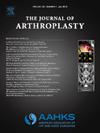10-Year Cumulative Incidence and Indications for Revision Total Joint Arthroplasty for Patients Who Have Ehlers-Danlos Syndrome
IF 3.8
2区 医学
Q1 ORTHOPEDICS
引用次数: 0
Abstract
Background
Long-term complications following total joint arthroplasty are not well established for patients who have Ehlers-Danlos syndrome (EDS), a group of connective tissue disorders. This study compared 10-year incidence of revision surgery after total hip arthroplasty (THA) and total knee arthroplasty (TKA) in patients who have and do not have EDS.
Methods
A retrospective cohort analysis was conducted using a national all-payer claims database from 2010 to 2021 to identify patients who underwent primary TKA or THA. Patients who had and did not have EDS were propensity score–matched by age, sex, and a comorbidity index. Kaplan-Meier analyses and Cox proportional hazard models were used to determine the cumulative incidence and risks of revision experienced by patients who have and do not have EDS.
Results
The EDS patients who underwent TKA had a higher risk of all-cause revision (hazard ratio [HR]: 1.50, 95% confidence interval [95% CI]: 1.09 to 2.07, P < .014) and risk of revision due to instability (HR = 2.49, 95% CI: 1.37 to 4.52, P < .003). The EDS patients who underwent THA had a higher risk of all-cause revision (HR = 2.32, 95% CI: 1.47 to 3.65, P < .001), revision due to instability (HR = 4.26, 95% CI: 2.17 to 8.36, P < .001), and mechanical loosening (HR = 3.63, 95% CI: 2.05 to 6.44, P < .001).
Conclusions
Patients who had EDS were found to have a higher incidence of revision within 10 years of undergoing TKA and THA compared to matched controls, especially for instability. Patients who have EDS should be counseled accordingly. Surgical technique and implant selection should include consideration for increased constraint in TKA and larger femoral heads or dual mobility articulations for THA.
Ehlers-Danlos 综合征患者进行翻修全关节置换术的 10 年累积发病率和适应症。
背景:对于患有埃勒斯-丹洛斯综合征(EDS)(一种结缔组织疾病)的患者,全关节成形术后的长期并发症尚未得到很好的确定。本研究比较了患有和未患有 EDS 的患者在全髋关节置换术(THA)和全膝关节置换术(TKA)后 10 年的翻修手术发生率:方法: 使用 2010 年至 2021 年期间的全国所有付费者索赔数据库进行了一项回顾性队列分析,以确定接受初级 TKA 或 THA 的患者。根据年龄、性别和合并症指数对患有和未患有 EDS 的患者进行倾向分数匹配。采用 Kaplan-Meier 分析和 Cox 比例危险模型来确定 EDS 患者和非 EDS 患者的累积发生率和翻修风险:接受TKA的EDS患者全因翻修风险较高(危险比(HR):1.50,95%置信区间(95% CI):1.09~2.07,P < 0.014),因不稳定而翻修的风险也较高(HR = 2.49,95% CI:1.37~4.52,P < 0.003)。接受THA的EDS患者发生全因性翻修(HR = 2.32,95% CI:1.47至3.65,P <0.001)、不稳定性翻修(HR = 4.26,95% CI:2.17至8.36,P <0.001)和机械性松动(HR = 3.63,95% CI:2.05至6.44,P <0.001)的风险较高:结论:与匹配的对照组相比,EDS患者在接受TKA和THA手术后10年内的翻修率较高,尤其是不稳定性翻修。应为 EDS 患者提供相应的建议。手术技术和植入物的选择应包括考虑增加TKA的约束,以及THA的较大股骨头或双活动关节。
本文章由计算机程序翻译,如有差异,请以英文原文为准。
求助全文
约1分钟内获得全文
求助全文
来源期刊

Journal of Arthroplasty
医学-整形外科
CiteScore
7.00
自引率
20.00%
发文量
734
审稿时长
48 days
期刊介绍:
The Journal of Arthroplasty brings together the clinical and scientific foundations for joint replacement. This peer-reviewed journal publishes original research and manuscripts of the highest quality from all areas relating to joint replacement or the treatment of its complications, including those dealing with clinical series and experience, prosthetic design, biomechanics, biomaterials, metallurgy, biologic response to arthroplasty materials in vivo and in vitro.
 求助内容:
求助内容: 应助结果提醒方式:
应助结果提醒方式:


